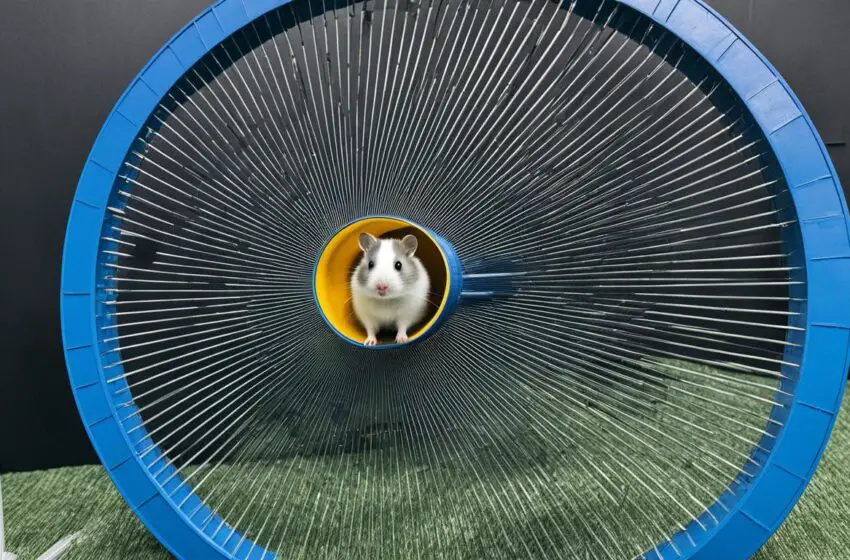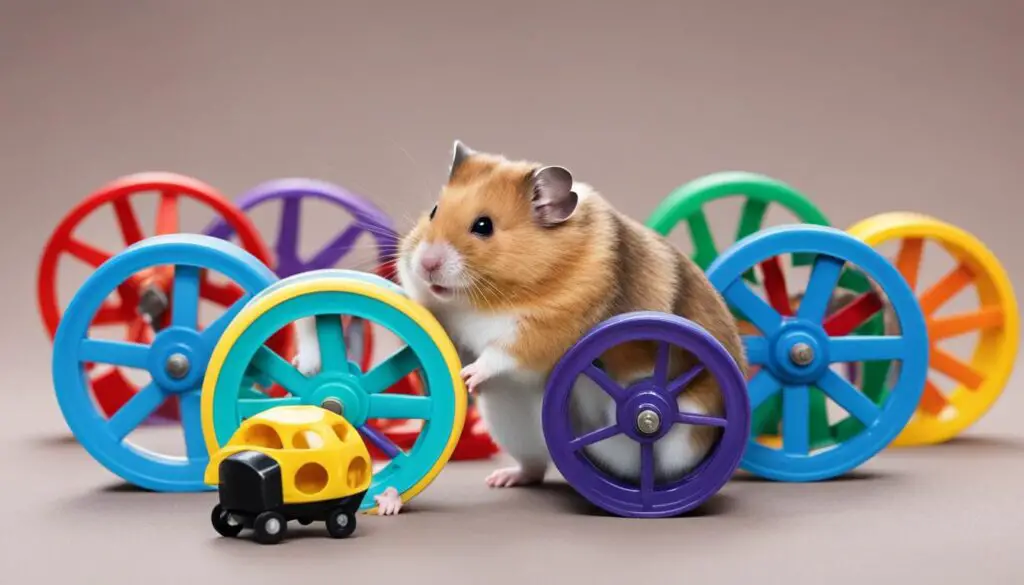Safety Tips for Choosing the Right Hamster Wheel

When it comes to providing our furry friends with the best possible care, their safety is always a top priority. This holds true for every aspect of their environment, including the accessories we choose for their enjoyment and exercise. One popular accessory for pet hamsters is the hamster wheel, which not only provides them with the opportunity to burn off extra energy but also adds a fun element to their daily routine.
However, it is crucial to select the right hamster wheel to ensure the safety and well-being of our hamster companions. With a wide range of options available in the market, it can be overwhelming to find the perfect fit. But fear not, because in this article, I will guide you through some important safety tips to consider when choosing a hamster wheel.
Key Takeaways:
- Choosing a safe hamster wheel is essential to avoid potential injuries or accidents.
- Consider factors such as size, materials, and design when selecting a hamster wheel.
- Proper placement and regular maintenance are crucial for your hamster’s safety.
- Explore alternative wheel options that offer improved safety features.
- Prioritizing safety will ensure your furry friend can enjoy their exercise without any risks or discomfort.
Why Safety is Important for Hamster Wheels
When it comes to choosing a hamster wheel for your furry friend, safety should always be your top priority. Hamster wheels are a popular accessory that provides exercise and entertainment for your pet. However, certain design features and materials can pose potential risks to their well-being. It is essential to understand the importance of hamster wheel safety and take the necessary precautions to keep your pet safe and happy.
Unstable or poorly constructed hamster wheels can lead to injuries or accidents. Your curious and energetic hamster may get their tiny feet caught in any gaps or openings in the wheel, causing painful injuries. Additionally, wheels that are not securely attached to the cage can tip over during use, potentially leading to more severe injuries.
The Consequences of Incorrect Sizing
Another safety concern is the incorrect sizing of the wheel. A wheel that is too small can cause discomfort and stress to your hamster. They may have to contort their bodies or run with an unnatural gait, which can lead to joint issues or muscle strains. On the other hand, a wheel that is too large for your hamster can make it difficult for them to run comfortably, potentially resulting in less exercise and a sedentary lifestyle.
The Importance of Adequate Ventilation
Inadequate ventilation is yet another safety consideration for hamster wheels. Proper airflow is essential to prevent your hamster from overheating during physical activity. A wheel with poor ventilation can trap heat and moisture, leading to discomfort, respiratory problems, and even heat stroke in extreme cases.
By prioritizing hamster wheel safety, you can provide a secure and enjoyable exercise environment for your pet. Ensuring stability, appropriate sizing, and adequate ventilation will help prevent injuries, discomfort, and potential health issues. Regular inspections and maintenance of the hamster wheel will also contribute to your pet’s safety and well-being.
Always keep in mind that a happy hamster is a safe hamster, and their well-being should be your ultimate goal as a responsible pet owner.
Factors to Consider When Choosing a Hamster Wheel
When it comes to selecting a hamster wheel, there are several important factors to consider. By keeping these factors in mind, you can ensure that your furry friend has a safe and enjoyable exercise experience. Let’s explore the key considerations for choosing the right hamster wheel.
Size of the Hamster
The size of your hamster is a crucial factor to consider when choosing a hamster wheel. It’s essential to provide enough space for your hamster to run comfortably without feeling cramped. A wheel that is too small can restrict their movements and cause discomfort. On the other hand, a wheel that is too large might be challenging for your hamster to navigate, potentially leading to accidents.
Materials and Construction
The materials and construction of the hamster wheel play a significant role in ensuring your pet’s safety. Opt for a wheel made of safe materials, such as solid plastic or metal, to prevent any potential harm. Avoid wheels with sharp edges or rough surfaces that could cause injuries to your hamster’s delicate paws. Additionally, choose a wheel with a solid base and a closed design to minimize the risk of your hamster getting caught or injured during exercise.
Noise Level
The noise level of the hamster wheel is another important consideration, especially if you plan to keep your hamster in your bedroom or a quiet area of your home. Look for wheels that are designed to operate silently, ensuring a peaceful environment for both you and your pet.
Stability
Ensuring that the hamster wheel is stable during use is crucial for your pet’s safety. A wobbly or unstable wheel can lead to accidents and injuries. Opt for a wheel with a sturdy and secure attachment mechanism to prevent any tipping or instability during your hamster’s exercise sessions.
Easy to Clean
Hygiene is an important aspect of pet care, and the hamster wheel is no exception. Look for a wheel that is easy to clean to maintain a clean and healthy living environment for your hamster. Wheels with detachable parts or smooth surfaces make cleaning a breeze, allowing you to remove any debris or soiled bedding easily.
Considering these factors when choosing a hamster wheel will help you make an informed decision and provide your furry friend with a safe and enjoyable exercise accessory. Remember, prioritizing your pet’s well-being is crucial when selecting any pet supplies.

Proper Placement of the Hamster Wheel
The placement of the hamster wheel plays a crucial role in ensuring your pet’s safety and comfort during exercise. Here are some important guidelines to follow:
Position the Wheel Securely:
The hamster wheel should be securely positioned in the cage to prevent it from tipping over or moving during use. This stability is essential to avoid any potential accidents or injuries to your hamster. Make sure to attach the wheel securely to the cage bars or choose a wheel with a reliable mounting system.
Away from Cage Accessories:
To avoid tangling or spillage, it is important to place the wheel away from cage accessories such as food bowls or water bottles. This prevents any interference that could affect your hamster’s exercise routine or create unnecessary mess in the cage.
Avoid Platforms or Structures:
When positioning the hamster wheel, be mindful to avoid placing it near any platforms or other built-in structures in the cage. This prevents the risk of your hamster accidentally falling off the platform while using the wheel, ensuring their safety at all times.
Proper placement of the hamster wheel contributes to a safe and enjoyable exercise experience for your furry friend. By following these guidelines, you can create an ideal cage setup that promotes your hamster’s well-being while they stay active on their wheel.
| Pros of Proper Placement | Cons of Improper Placement |
|---|---|
| Ensures stability during use | Increased risk of accidents or injuries |
| Prevents tangling or spillage | Interference with cage accessories |
| Minimizes the risk of falls | Potential harm from platforms or structures |
Regular Inspections and Maintenance
Ensuring the safety of your pet hamster includes regular inspections and maintenance of the hamster wheel. By carefully examining the wheel for any signs of damage or wear, you can prevent potential hazards and keep your furry friend safe during playtime.
During your wheel inspections, be on the lookout for loose or broken parts, sharp edges, or any rough surfaces that could cause injuries to your hamster. If you notice any issues, it’s important to address them promptly. Tighten or replace loose parts, file down sharp edges, and sand rough surfaces to create a smooth and safe environment for your pet.
Furthermore, maintaining a clean wheel is crucial for both the durability of the wheel and the well-being of your hamster. Regularly remove any debris or soiled bedding from the wheel to prevent it from accumulating and potentially causing discomfort or health issues. This simple cleaning routine contributes to a hygienic and hazard-free playtime experience for your pet.
In addition to inspections and cleaning, implementing a maintenance schedule can greatly extend the lifespan of the hamster wheel. Periodically lubricating any moving parts, such as the axle or bearings, can help reduce friction and ensure smooth operation. Consult the manufacturer’s guidelines or seek advice from a trusted veterinarian on the appropriate lubricant to use.
To summarize, conducting regular inspections and maintenance checks on the hamster wheel is a fundamental aspect of responsible pet care. By identifying and addressing any potential dangers or wear, you can provide a safe and enjoyable exercise experience for your hamster.

| Benefits of Regular Wheel inspections and maintenance: |
|---|
| Identify loose or broken parts |
| Prevent injuries from sharp edges or rough surfaces |
| Maintain a clean and hygienic wheel |
| Reduce friction and ensure smooth operation through lubrication |
Alternatives to Traditional Hamster Wheels
If you are concerned about the safety of traditional hamster wheels, there are alternative options available. You can consider purchasing a flying saucer-style wheel or a silent spinner wheel, both of which offer unique designs that minimize potential risks. These alternatives provide a safer and quieter exercise experience for your furry friend.
The flying saucer-style wheel is a popular choice among hamster owners. Its open, disc-shaped design allows hamsters to run freely without the risk of getting their tails or paws caught. The absence of bars or spokes reduces the chance of injuries, providing a safer environment for your pet.
The silent spinner wheel, as the name suggests, is designed to minimize noise. It operates smoothly and quietly, ensuring a peaceful environment for both you and your hamster. The wheel’s solid surface and closed design also eliminate the risk of entanglement or injury.
| Alternative Wheel Option | Benefits |
|---|---|
| Flying saucer-style wheel |
|
| Silent spinner wheel |
|
By exploring these alternative wheel options, you can provide your hamster with a safer exercise experience while ensuring their physical and mental well-being. Remember to consider your hamster’s size, preferences, and specific needs when selecting an alternative wheel.
Conclusion
When it comes to the safety of your hamster, choosing the right wheel is of utmost importance. By considering factors such as size, materials, and proper placement, you can ensure that your furry friend can enjoy their exercise without any risks or discomfort.
Regular inspections and maintenance are crucial in keeping your hamster wheel safe. By checking for any signs of damage or wear, you can address any issues promptly and ensure the longevity of the wheel. Additionally, keeping the wheel clean and free from debris and soiled bedding will provide a hygienic environment for your pet.
If you have concerns about traditional hamster wheels, there are alternatives available that offer safer designs. Flying saucer-style wheels and silent spinner wheels provide unique options that minimize potential risks. Exploring these alternatives can provide your hamster with a safe and enjoyable exercise experience.
In conclusion, by prioritizing safety and following these tips, you can provide your hamster with a secure and enjoyable playtime experience. Remember to consider the size, materials, and placement of the wheel, regularly inspect and maintain it, and explore alternative options if needed. Your hamster’s well-being and happiness are worth the effort in ensuring their safety.
FAQ
Why is safety important when choosing a hamster wheel?
Safety is crucial when selecting a hamster wheel to ensure your pet remains protected and happy during playtime. Certain design features and materials can pose risks to your hamster, and unstable or poorly constructed wheels can cause injuries or accidents. Prioritizing safety helps prevent harm to your furry friend.
What factors should I consider when choosing a hamster wheel?
When selecting a hamster wheel, consider the size of your hamster and choose a wheel that provides enough space for them to run comfortably. Opt for a wheel made of safe materials, such as solid plastic or metal, with a solid base and a closed design to avoid any risks of your hamster getting caught or injured.
How should I properly place the hamster wheel in the cage?
Position the hamster wheel securely in the cage to ensure it doesn’t tip over during use. Place it away from any cage accessories, such as food bowls or water bottles, to prevent tangling or spillage. Additionally, avoid placing the wheel near platforms or other structures that your hamster could potentially fall from.
How often should I inspect and maintain the hamster wheel?
It’s essential to regularly inspect the hamster wheel for any signs of damage or wear. Check for loose or broken parts, sharp edges, or any rough surfaces that could cause injuries to your hamster. Additionally, keep the wheel clean by removing any debris or soiled bedding regularly. Regular inspections and maintenance ensure the wheel’s durability and keep your hamster safe during playtime.
Are there alternatives to traditional hamster wheels?
Yes, if you are concerned about the safety of traditional hamster wheels, there are alternative options available. You can consider purchasing a flying saucer-style wheel or a silent spinner wheel, both of which offer unique designs that minimize potential risks. These alternatives provide a safer and quieter exercise experience for your furry friend.
What is the conclusion regarding hamster wheel safety?
When choosing a hamster wheel, prioritizing safety is essential. Consider factors like size, materials, and proper placement to ensure your hamster can enjoy their exercise without any risks or discomfort. Regular inspections and maintenance, along with exploring safer alternatives if needed, will contribute to a safe and enjoyable playtime experience for your pet.



